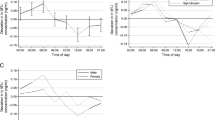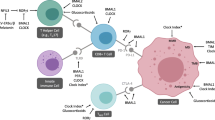Summary
Sixty-three patients were randomised into two groups each receiving the same 40-h sequential chemotherapy regimen (methotrexate or 5-FU, followed by vinblastine and cyclophosphamide). In the group receiving influsions of chemotherapeutic agents at times taking into account the circadian rhythm of tumoral proliferation, the antitumoral effectiveness appeared significantly better with respect to both tumoral regressions (85% contrasting with 58% in the other group) and the duration of response and survival.
Similar content being viewed by others
References
Badran, A.F., Echave Llanos, J.M.: Persistence of mitotic circadian rhythm of a transplantable mammary carcinoma after 35 generations: its bearing on the success of treatment with endoxan. J. Natl. Cancer Inst. 2, 285 (1965)
Barbason, H., Lelievre, P.: Influence du rythme de l'activité circadienne sur les différentes phases du premier cycle cellulaire suivant une hépatectomie partielle. C.R. Acad. Sci. [D] (Paris) 271, 1798 (1970)
Barbiroli, B., Potter, V.R., Morris, H. P.: DNA synthesis in Morris hepatoma 9618A and in host liver following hepatectomy in rats adapted to controlled feeding schedules. Cancer Res. 32, 7 (1972)
Berezkin, M. V.: A comparative study of the circadian rhythm of mitotic activity in neoplasia and normal tissues. [In Russian.] Biull. Eksp. Biol. Med. 70, 83 (1970)
Echave Llanos, J. M., Nash, R. E.:Mitotic circadian rhythms in a fast-growing and a slow-growing hepatoma: mitotic rhythm in hepatoma. J. Natl. Cancer Inst 3, 581 (1970)
Focan, C.: Chimiothérapie séquentielle basée sur, l'hypothèse d'un rythme circadien de la prolifération tumorale. Nouv. Presse Med. 4, 2709 (1975)
Focan, C.: Rythme nycthéméral de la division et chimiothérapie de synchronisation-recrutement en cancérologie clinique. Rev. Méd. Liège 31, 461 (1975)
Focan, C., Pierard, G.: Variation circadiennes de la prolifération cellulaire dans des tumeurs épidermiques. Bull. Soc. Fr. Dermat. Syphil. Paris 83, 331 (1976)
Focan, C., Barbason, H., Betz, E. H.: Influence du rythme nycthéméral des divisions cellulaires sur l'efficacité de la cyclophosphamide contre des sarcomes induits par le méthylcholanthrène. C.R. Acad. Sci. [D] (Paris) 276, 2105 (1973)
Focan, C., Barbason, H., Betz, E. H.: Mise en évidence d'un rythme nycthéméral de la division cellulaire dans des sarcomes induits par le méthylcholanthrène. C.R. Acad. Sci [D] (Paris) 276, 2229 (1973)
Focan, C., Barbason, H., Betz, E. H.: Use of synchronization induced by cyclophosphamide in a methylcholanthrene sarcoma with circadian proliferation to rational sequential chemotherapy. Biomedicine 23, 230 (1975)
Garcia Sainz, M., Halberg, F.: Mitotic rhythm in human cancer reevaluated by electronic computer programs. Evidence for chronopathology. J. Natl. Cancer Inst. 37, 279 (1966)
Gehan, E. A.: Statistical methods for survival time studies. In: Cancer therapy: prognostic factors and criteria of response. Staquet, M. J. (ed.), p. 7. New York: Raven Press 1975
Kahn, G., Weistein, G. D., Frost, P.: Kinetics of human epidermal cell proliferation: diural variations. J. Invest. Dermatol. 50, 459 (1968)
Mamontov, S. G.: Diurnal rhythm of mitoses in the epithelium of the mouse tongue. Biull. Eksp. Biol. Med. 66, 1277 (1968)
Nash, R. E., Echave Llanos, J. M.: Twenty-four hours variations in DNA synthesis of a fast-growing and a slow-growing hepatoma: DNA synthesis rhythm in hepatoma. J. Natl. Cancer Inst. 5, 1007 (1971)
Nitze, H. R., Roseman, H. R.: Die Beeiflussung des Zellteillungsrhythmus bei menschlichen Tumoren. Arch. klin. exp. Ohr-, Nas-, u. Kelhlk.-Heilkd. 193, 101 (1969)
Potten, C. S., Jessup, B. A., Croxson, M. B.: Incorporation of tritiated thymidine into the skin and hair follicles. II. Daily fluctuations in 3H-T-d-R and 3H-U-R levels. Cell Tissue Kinet. 4, 413 (1971)
Pullman, H., Lennartz, K. J., Steigleder, G. K.: In vitro examinations of cell proliferation in normal and psoriatic epidermis with special regard to diurnal variations. Arch. Dermatol. Forsch. 250, 177 (1974)
Tähti, E.: Studies of the effect of X radiations on 24 hours variations in the mitotic activity in human malignant tumours. Acta Pathol. Microbiol. Scand. [A] (Suppl.) 117, 1 (1956)
Tvermyr, E. M. F.: Circadian rhythm in hairless mouse epidermal DNA synthesis as measured by double labelling with 3H-thymidine (3H-T-d-R). Virchows Arch. [Cell Pathol] 11, 43 (1972)
Voutilainen, A.: Über die 24 Stunden-Rhythmik der Mitosen-Frequenz in malignen Tumoren. Acta Pathol Microbiol. Scand. [A] (Suppl.) 99, 1 (1953)
Author information
Authors and Affiliations
Rights and permissions
About this article
Cite this article
Focan, C. Sequential chemotherapy and circadian rhythm in human solid tumours. Cancer Chemother. Pharmacol. 3, 197–202 (1979). https://doi.org/10.1007/BF00262422
Received:
Accepted:
Issue Date:
DOI: https://doi.org/10.1007/BF00262422




